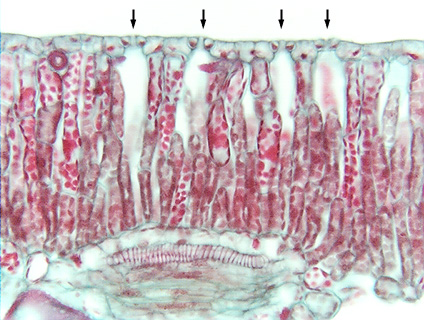 Fig.
10.3-14. Transverse section of water lily leaf (Nymphaea).
This micrograph shows the upper epidermis (the palisade parenchyma is just below
it) and it contains many stomata. The lower epidermis is not visible, but it has
no stomata. Can you
explain the adaptive significance of this anatomy?
Fig.
10.3-14. Transverse section of water lily leaf (Nymphaea).
This micrograph shows the upper epidermis (the palisade parenchyma is just below
it) and it contains many stomata. The lower epidermis is not visible, but it has
no stomata. Can you
explain the adaptive significance of this anatomy?
This is a species of water lily whose leaves float on the surface of a pond or lake. If it were like an ordinary leaf, it would have the majority of its stomata in the lower epidermis, pressed against the water’s surface – they would be unable to absorb any carbon dioxide from the atmosphere. This arrangement – having all the stomata in the upper epidermis – permits the leaves to absorb carbon dioxide. It also causes them to lose much more water, but that is not much of a problem for water lilies. This unusual anatomy would not be adaptive for most terrestrial species, but it is functional in this particular habitat.